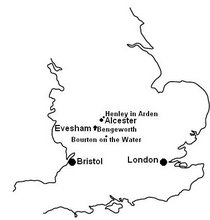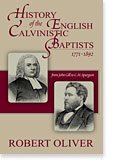In Beddome’s lifetime he published little. His Midland Association circular letters were published in 1759 and 1765 and some individual sermons and hymns also appeared in his lifetime. On February 27th, 1752, A scriptural exposition of the Baptist Catechism by way of question and answer was issued. (It was republished in 1776 and later again in 1814 and 1849 and is now available in a modern edition). Lamenting the demise of catechising in families and noting the success of a similar effort by Matthew Henry (1662-1714), (Henry’s Scripture Catechism of 1702. He also wrote A plain Catechism for children. Cf Holmes, 62). Beddome wrote,
May the great God smile upon this faint attempt for his glory, and may that church especially, to which I stand related, accept it as a small acknowledgement of their many favours and a token of the sincerest gratitude and affection from their willing though unworthy servant.'
(Beddome, A scriptural exposition of the Baptist Catechism by way of question and answer, Bristol, W Pine, 2nd ed, 1776, iv).
Catechising, the use of questions and answers to teach Christian doctrine, has a long and honourable history. The early church had a high view of it and appointed catechists whose main work was to catechise men and women and children. Tom Nettles has spoken of the Reformation as ‘The Golden age of catechisms’, the Heidelberg and Westminster Catechisms having had most impact. (Nettles, Teaching truth, training hearts, the study of catechisms in Baptist life, Amityville, New York, Calvary Press, 1998, 17).
In 1680 Hercules Collins (d 1702) adapted the Heidelberg document for Baptist use under the title An orthodox catechism. (Probably connected with the Petty France congregation Collins was initially the respected minister from 1677 of a Baptist church at Wapping, London, that 10 years later moved to Stepney. He had few educational opportunities but authored several books. He suffered imprisonment for Baptist beliefs 1684. He was buried in Bunhill Fields. See here for more.)
Henry Jessey (1603-1633) another eminent early Baptist, produced a threefold catechism aimed at various levels and called it A catechism for babes or little ones. The simplest of these contained only four questions – what man was, is, may be and must be! See here. (Highly regarded as a scholar, author and humanitarian, Yorkshire born Jessey was a Cambridge graduate. He left parish ministry for London, 1635, and pastured the persecuted church gathered by Jacob and Lathrop from 1637. It divided, 1640, Jessey’s church moving increasingly to a Baptist position. Following a split with Kiffin, 1644, Jessey was baptised as a believer. Despite being identified with Fifth Monarchists at times, he was orthodox. Troubles increased after the Restoration and for a short spell he was in Holland. On returning he died, September 4, 1663. Thousands attended his funeral.)
Several other Baptist catechisms, including one by John Bunyan (1628-1688), have appeared down the years but the one that was to become most popular among Particular Baptists was that based on the Westminster shorter catechism and known as Keach’s catechism. (Among General Baptists, Nettles reveals, Thomas Grantham’s 1687 St Paul’s Catechism was popular and Dan Taylor’s later A catechism of instruction for children and youth which had gone through 8 editions by 1810.) Nettles goes as far as to say ‘Perhaps more than all others combined, this catechism defined what it was to be a Baptist throughout the eighteenth century and for some years into the nineteenth.’ (Nettles, 47). The catechism was prepared around 1693, the year in which a general assembly of Particular Baptist churches took place in London and where it was agreed
down the years but the one that was to become most popular among Particular Baptists was that based on the Westminster shorter catechism and known as Keach’s catechism. (Among General Baptists, Nettles reveals, Thomas Grantham’s 1687 St Paul’s Catechism was popular and Dan Taylor’s later A catechism of instruction for children and youth which had gone through 8 editions by 1810.) Nettles goes as far as to say ‘Perhaps more than all others combined, this catechism defined what it was to be a Baptist throughout the eighteenth century and for some years into the nineteenth.’ (Nettles, 47). The catechism was prepared around 1693, the year in which a general assembly of Particular Baptist churches took place in London and where it was agreed
'That a catechism be drawn up, containing the substance of the Christian religion, for the instruction of children and servants; and that Brother William Collins be desired to draw it up.' (Nettles, 49).
This (unrelated) Collins was co-pastor with Nehemiah Cox of a church in Petty France, London, from 1673 until his death in 1702. With Cox he had been responsible for publishing the Confession of faith of 1677, the confession ratified in 1689 and known as the Second London Confession. No-one knows why the name of ‘Famous Mr Keach’ is so firmly connected with the catechism. Benjamin Keach (1640-1704) was certainly the leading Baptist of his day. Originally an Arminian, he became a pastor first in his native Buckinghamshire and then in 1668 at Horsley Down, London. A prolific author, in 1664 he had published The Child’s instructor or A new and easy primer. For this he was arrested, jailed, twice pilloried and ‘saw his book burnt under his nose’. (Nettles, 50).
What Beddome’s version of Keach does is to give supplementary questions and Scripture texts for each of the original 114 questions. This catechism was widely used and was reprinted in 1776. In his letter to the Midland Association in 1754 reporting on the church Beddome mentions the successful use of the catechism with all ages. Holmes suggests that it was part of the key to his earlier success in Bourton and points out that later decline coincided with the fall off of its use. (Cf Holmes, 62. He highlights Wilkins’ refusal to engage in catechising due to other engagements. He also notes, 145, that on at least two occasions, 1753 and 1786, the church purchased catechisms for distribution to the poor.) The catechism reveals Beddome to be no Hyper-Calvinist or antinomian but a Strict and Particular Baptist and a Sabbatarian in the best sense.
Catechising, the use of questions and answers to teach Christian doctrine, has a long and honourable history. The early church had a high view of it and appointed catechists whose main work was to catechise men and women and children. Tom Nettles has spoken of the Reformation as ‘The Golden age of catechisms’, the Heidelberg and Westminster Catechisms having had most impact. (Nettles, Teaching truth, training hearts, the study of catechisms in Baptist life, Amityville, New York, Calvary Press, 1998, 17).
In 1680 Hercules Collins (d 1702) adapted the Heidelberg document for Baptist use under the title An orthodox catechism. (Probably connected with the Petty France congregation Collins was initially the respected minister from 1677 of a Baptist church at Wapping, London, that 10 years later moved to Stepney. He had few educational opportunities but authored several books. He suffered imprisonment for Baptist beliefs 1684. He was buried in Bunhill Fields. See here for more.)
Henry Jessey (1603-1633) another eminent early Baptist, produced a threefold catechism aimed at various levels and called it A catechism for babes or little ones. The simplest of these contained only four questions – what man was, is, may be and must be! See here. (Highly regarded as a scholar, author and humanitarian, Yorkshire born Jessey was a Cambridge graduate. He left parish ministry for London, 1635, and pastured the persecuted church gathered by Jacob and Lathrop from 1637. It divided, 1640, Jessey’s church moving increasingly to a Baptist position. Following a split with Kiffin, 1644, Jessey was baptised as a believer. Despite being identified with Fifth Monarchists at times, he was orthodox. Troubles increased after the Restoration and for a short spell he was in Holland. On returning he died, September 4, 1663. Thousands attended his funeral.)
Several other Baptist catechisms, including one by John Bunyan (1628-1688), have appeared
 down the years but the one that was to become most popular among Particular Baptists was that based on the Westminster shorter catechism and known as Keach’s catechism. (Among General Baptists, Nettles reveals, Thomas Grantham’s 1687 St Paul’s Catechism was popular and Dan Taylor’s later A catechism of instruction for children and youth which had gone through 8 editions by 1810.) Nettles goes as far as to say ‘Perhaps more than all others combined, this catechism defined what it was to be a Baptist throughout the eighteenth century and for some years into the nineteenth.’ (Nettles, 47). The catechism was prepared around 1693, the year in which a general assembly of Particular Baptist churches took place in London and where it was agreed
down the years but the one that was to become most popular among Particular Baptists was that based on the Westminster shorter catechism and known as Keach’s catechism. (Among General Baptists, Nettles reveals, Thomas Grantham’s 1687 St Paul’s Catechism was popular and Dan Taylor’s later A catechism of instruction for children and youth which had gone through 8 editions by 1810.) Nettles goes as far as to say ‘Perhaps more than all others combined, this catechism defined what it was to be a Baptist throughout the eighteenth century and for some years into the nineteenth.’ (Nettles, 47). The catechism was prepared around 1693, the year in which a general assembly of Particular Baptist churches took place in London and where it was agreed'That a catechism be drawn up, containing the substance of the Christian religion, for the instruction of children and servants; and that Brother William Collins be desired to draw it up.' (Nettles, 49).
This (unrelated) Collins was co-pastor with Nehemiah Cox of a church in Petty France, London, from 1673 until his death in 1702. With Cox he had been responsible for publishing the Confession of faith of 1677, the confession ratified in 1689 and known as the Second London Confession. No-one knows why the name of ‘Famous Mr Keach’ is so firmly connected with the catechism. Benjamin Keach (1640-1704) was certainly the leading Baptist of his day. Originally an Arminian, he became a pastor first in his native Buckinghamshire and then in 1668 at Horsley Down, London. A prolific author, in 1664 he had published The Child’s instructor or A new and easy primer. For this he was arrested, jailed, twice pilloried and ‘saw his book burnt under his nose’. (Nettles, 50).
What Beddome’s version of Keach does is to give supplementary questions and Scripture texts for each of the original 114 questions. This catechism was widely used and was reprinted in 1776. In his letter to the Midland Association in 1754 reporting on the church Beddome mentions the successful use of the catechism with all ages. Holmes suggests that it was part of the key to his earlier success in Bourton and points out that later decline coincided with the fall off of its use. (Cf Holmes, 62. He highlights Wilkins’ refusal to engage in catechising due to other engagements. He also notes, 145, that on at least two occasions, 1753 and 1786, the church purchased catechisms for distribution to the poor.) The catechism reveals Beddome to be no Hyper-Calvinist or antinomian but a Strict and Particular Baptist and a Sabbatarian in the best sense.











